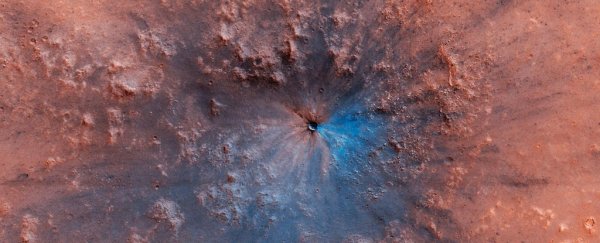Mars. Water. You'd never find two more unlikely companions, even in a buddy cop movie. But once upon a time, the dry, red dustbowl of Mars was lush and soggy.
We're still unravelling the history of that water, and planetary scientists have just discovered at least two distinct reservoirs of ancient water could be preserved under the Martian surface, with different chemical signatures.
This finding indicates that, unlike Earth, Mars probably didn't have one big global ocean of underground magma encircling the entire planet.
"A lot of people have been trying to figure out Mars' water history," explained planetary scientist Jessica Barnes of the University of Arizona.
"Where did water come from? How long was it in the crust (surface) of Mars? Where did Mars' interior water come from? What can water tell us about how Mars formed and evolved?"
The evidence was found in Mars rocks. We can't exactly nip over to Mars and fetch them; indeed, to date we haven't even conducted a robotic Mars sample return mission. But occasionally, Mars comes to us anyway.
Meteorites broken off from the Martian crust will, from time to time, make their way to Earth. Here in Earth labs, using state-of-the-art techniques, researchers carefully studied two such meteorites - Allan Hills 84001, discovered in Antarctica 1984, and Northwest Africa 7034, discovered in the Sahara Desert in 2011.
The team looked at the isotopes of hydrogen locked inside the Mars rocks. Isotopes are variants of an element with different numbers of neutrons; deuterium - also known as heavy hydrogen - has one proton and one neutron. Protium, or light hydrogen, has one proton and no neutrons.
Because hydrogen is one of the components of water, the ratio of these two isotopes locked in rocks can help us to understand the history of the water they were in - it's like a fossil of water, an imprint of its presence that can be analysed to learn the chemical processes it was subject to, and its origins.
Barnes and her team are not the first to study hydrogen isotopes in Martian meteorites in order to try to learn about the planet's water. But previous results have been scattered and inconsistent.
Here on Earth, protium is the dominant hydrogen isotope. That's true for the atmosphere (although there's not much hydrogen there), the water hydrogen in rocks, and the water in the ocean.
On Mars, deuterium is the dominant hydrogen isotope in the atmosphere, likely because solar radiation is stripping the protium - but isotope ratios in the rocks tested by scientists have run from Earth-like to Mars-like.
So, Barnes and her team decided to take a closer look at meteorites they knew for a certainty originated in the Martian crust.
Allan Hills 84001, according to previously conducted radioactive decay dating techniques, interacted with fluid in the Martian crust around 3.9 billion years ago. Similar analysis determined that Northwest Africa 7034 interacted with fluid 1.5 billion years ago.
When Barnes and her team conducted their isotope analysis, they found that both samples had similar isotope ratios, sitting comfortably in between the ratio found in Earth's water and the ratio found in the Martian atmosphere. Even more peculiarly, this ratio was similar to younger rocks analysed by the Curiosity rover right there on Mars.
This indicates that the chemical composition of that water has been consistent for around 3.9 billion years - a completely unexpected result, given the previous research
"Martian meteorites basically plot all over the place, and so trying to figure out what these samples are actually telling us about water in the mantle of Mars has historically been a challenge," Barnes said.
"The fact that our data for the crust was so different prompted us to go back through the scientific literature and scrutinise the data."
But when the team compared their results with previous research on hydrogen isotopes in meteorites from the Martian mantle - below the crust - they found something really surprising. Mantle meteorites fit into two distinct groups of igneous rock called shergottite.
Enriched shergottite has more deuterium; depleted shergottite has less deuterium. Average out their two ratios, and you get the crustal ratio seen in Allan Hills 84001 and Northwest Africa 7034.
Those two distinct chemical signatures indicate two different, unmixed reservoirs of water in the Martian mantle. Which may mean that, unlike Earth, a global ocean of liquid magma below the mantle did not homogenise the layer above.
"These two different sources of water in Mars' interior might be telling us something about the kinds of objects that were available to coalesce into the inner, rocky planets," Barnes said.
"This context is also important for understanding the past habitability and astrobiology of Mars."
The research has been published in Nature Geoscience.
